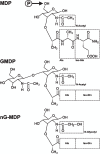Vaccines and Dementia: Part I. Non-Specific Immune Boosting with BCG: History, Ligands, and Receptors
- PMID: 38393912
- PMCID: PMC10977417
- DOI: 10.3233/JAD-231315
Vaccines and Dementia: Part I. Non-Specific Immune Boosting with BCG: History, Ligands, and Receptors
Abstract
Vaccines such as Bacille Calmette-Guérin (BCG) can apparently defer dementia onset with an efficacy better than all drugs known to date, as initially reported by Gofrit et al. (PLoS One14, e0224433), now confirmed by other studies. Understanding how and why is of immense importance because it could represent a sea-change in how we manage patients with mild cognitive impairment through to dementia. Given that infection and/or inflammation are likely to contribute to the development of dementias such as Alzheimer's disease (Part II of this work), we provide a historical and molecular background to how vaccines, adjuvants, and their component molecules can elicit broad-spectrum protective effects against diverse agents. We review early studies in which poxvirus, herpes virus, and tuberculosis (TB) infections afford cross-protection against unrelated pathogens, a concept known as 'trained immunity'. We then focus on the attenuated TB vaccine, BCG, that was introduced to protect against the causative agent of TB, Mycobacterium tuberculosis. We trace the development of BCG in the 1920 s through to the discovery, by Freund and McDermott in the 1940 s, that extracts of mycobacteria can themselves exert potent immunostimulating (adjuvant) activity; Freund's complete adjuvant based on mycobacteria remains the most potent immunopotentiator reported to date. We then discuss whether the beneficial effects of BCG require long-term persistence of live bacteria, before focusing on the specific mycobacterial molecules, notably muramyl dipeptides, that mediate immunopotentiation, as well as the receptors involved. Part II addresses evidence that immunopotentiation by BCG and other vaccines can protect against dementia development.
Keywords: Adjuvant; Alzheimer’s disease; Bacille Calmette–Guérin; Freund; NOD2; YB-1; immunopotentiation; muramyl dipeptide; mycobacteria; trained immunity; vaccine.
Conflict of interest statement
The authors have no conflict of interest to report.
Figures




Similar articles
-
Vaccines and Dementia: Part II. Efficacy of BCG and Other Vaccines Against Dementia.J Alzheimers Dis. 2024;98(2):361-372. doi: 10.3233/JAD-231323. J Alzheimers Dis. 2024. PMID: 38393913 Free PMC article. Review.
-
Next-Generation Vaccines Based on Bacille Calmette-Guérin.Front Immunol. 2018 Feb 5;9:121. doi: 10.3389/fimmu.2018.00121. eCollection 2018. Front Immunol. 2018. PMID: 29459859 Free PMC article. Review.
-
Bacille Calmette Guérin (BCG) and new TB vaccines: Specific, cross-mycobacterial and off-target effects.Paediatr Respir Rev. 2020 Nov;36:57-64. doi: 10.1016/j.prrv.2020.08.004. Epub 2020 Aug 20. Paediatr Respir Rev. 2020. PMID: 32958428 Free PMC article. Review.
-
NOD2/RIG-I Activating Inarigivir Adjuvant Enhances the Efficacy of BCG Vaccine Against Tuberculosis in Mice.Front Immunol. 2020 Dec 7;11:592333. doi: 10.3389/fimmu.2020.592333. eCollection 2020. Front Immunol. 2020. PMID: 33365029 Free PMC article.
-
Listeria-Vectored Multiantigenic Tuberculosis Vaccine Enhances Protective Immunity against Aerosol Challenge with Virulent Mycobacterium tuberculosis in BCG-Immunized C57BL/6 and BALB/c Mice.mBio. 2022 Jun 28;13(3):e0068722. doi: 10.1128/mbio.00687-22. Epub 2022 Jun 1. mBio. 2022. PMID: 35642945 Free PMC article.
Cited by
-
Immunostimulatory effects of Toll-like receptor ligands as adjuvants in establishing a novel mouse model for pemphigus vulgaris.Clin Transl Med. 2024 Jul;14(7):e1765. doi: 10.1002/ctm2.1765. Clin Transl Med. 2024. PMID: 39031979 Free PMC article.
-
Vaccines and Dementia: Part II. Efficacy of BCG and Other Vaccines Against Dementia.J Alzheimers Dis. 2024;98(2):361-372. doi: 10.3233/JAD-231323. J Alzheimers Dis. 2024. PMID: 38393913 Free PMC article. Review.
-
Chlamydia pneumoniae in Alzheimer's disease pathology.Front Neurosci. 2024 May 6;18:1393293. doi: 10.3389/fnins.2024.1393293. eCollection 2024. Front Neurosci. 2024. PMID: 38770241 Free PMC article. Review.
References
-
- Ristori G, Romano S, Cannoni S, Visconti A, Tinelli E, Mendozzi L, Cecconi P, Lanzillo R, Quarantelli M, Buttinelli C, Gasperini C, Frontoni M, Coarelli G, Caputo D, Bresciamorra V, Vanacore N, Pozzilli C, Salvetti M (2014) Effects of Bacille Calmette-Guérinafter the first demyelinating event in the CNS. Neurology 82, 41–48. - PMC - PubMed
-
- Kim JI, Zhu D, Barry E, Kovac E, Aboumohamed A, Agalliu I, Sankin A (2021) Intravesical Bacillus Calmette-Guérin treatment isinversely associated with the risk of developing Alzheimer diseaseor other dementia among patients with non-muscle-invasive bladdercancer. Clin Genitourin Cancer 19, e409–e416. - PubMed
Publication types
MeSH terms
Substances
LinkOut - more resources
Full Text Sources
Medical

